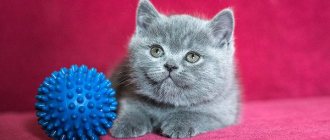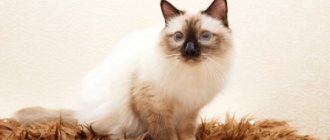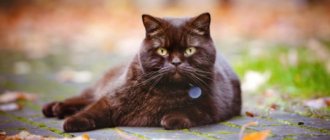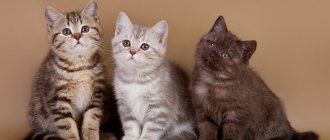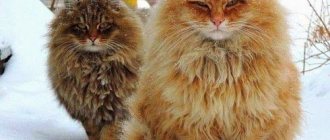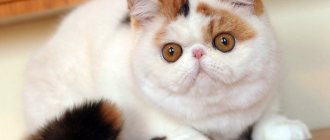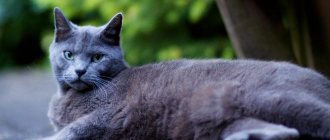You can’t describe the character of a British cat in a few words. It’s the same as saying about Napoleon’s life “he led France.” Only, the British are not French. They are proud, sometimes arrogant. We are talking about cats, about them - cats of the British breed.
Only this fact does not mean that representatives of the breed never want to be petted. They want it, but when they need it, and not at the moment when the owner takes it into his head. This cat is a personality. He has an opinion that must be taken into account. To understand what kind of character British cats have, you need to watch them a little, or better yet, live in the same house for several weeks.
History of the origin of the British Shorthair cat
There are several versions of the origin of the breed, but the most common and reliable is associated with the arrival of Roman conquerors to British lands. It is believed that cats saved provisions in the holds from rodents and therefore were valued not for the beauty of their fur, but for their hunting skills.
Having moved to the ground, cats lived side by side with people, helping them fight rodents on the farm. At that time, the cats' bodies were slender and longer and more graceful, like those of Egyptian cats.
Only in the middle of the 19th century did people pay attention to the British as attractive animals, and it became fashionable to keep them in the house. In 1871, an exhibition was held in London, where various cats were presented, including the blue tabby Old Lady - a representative of the modern British shorthair breed. At that time, it was the blue color of the coat that was considered a sign of the breed, and other colors were not recognized.
The war period had a negative impact on the number of purebred cats, so in peacetime the British were crossed with the Persian breed, Russian Blue, and Chartreuse. Thanks to this, we can now enjoy the variety of colors, natural strength and strong physique of cats that they inherited from their ancestors.
In the 70s of the last century, the breed became officially recognized and registered, and first appeared in Russia in 1980.
Cleanliness
Each cat approaches its appearance with special responsibility. British Shorthairs will look perfect in any circumstances. Like real aristocrats, they will spend hours getting their paws, antennae and fur in order. Sometimes, self-care for cats of this breed is a great way to relieve stress and bring yourself to psychological calm.
Licking is not just a way for a cat to groom itself. This ritual can be interpreted in different ways:
- Mean support or attention to other animals living in the house;
- A mother cat licks an angry kitten to calm it down;
- Licking is a sign of friendship and trust, that is, a cat will never lick a pet that is unpleasant to it.
Kittens begin to repeat this ritual after adults at 5-6 weeks, maintaining it into adulthood.
Description of the breed
The British Shorthair breed is considered quite common. The physical features and character of these cats have been shaped over centuries. The result was a harmoniously developed organism with an incredible variety of colors, an easy-going character and unpretentious maintenance. The breed standard often contains the word "round", and this perfectly describes the physical characteristics of the British. The animal has a high life expectancy - 12-17 years.
Lewis Carroll immortalized the image of the British cat in the Cheshire Cat, who smiled happily from the pages of the book about Alice.
Coat and colors
The coat of the British Shorthair cat is a source of pride and admiration. It feels plush, dense and is an indicator of the pet’s health. The presence of a healthy shine and smoothness indicates the absence of problems. The colors of the British are numerous and within each of them there are many shade options.
Solid coat color can be purple, black, white, red, blue. The chocolate shade is considered the rarest and therefore the most desirable. The more pronounced the “choco” color, the more expensive the individual is. White cats can have different colored eyes.
The rarest monochromatic colors are considered to be fawn and cinnamon (cinnamon).
The tortoiseshell color is found mainly in females, and if a male kitten with this color is born, he is usually infertile. The tortoiseshell color with red and white spots is highly prized.
The color of the chinchilla looks incredibly elegant: cats with shaded silver or golden fur are considered expensive. When paired with lilac, blue or green eyes, they look royal!
The bicolor color is characterized by the presence of spots of black, red, blue on a white background.
The Whiskas color is distinguished by clear gray stripes that clearly stand out against the light coat.
Color point is considered a Siamese color, which adds charm to the British cat. And the tabby color makes the animal look like a tiger due to spots or stripes on the body.
Constitution
The body of the British cat is strong and harmoniously developed. The head is rounded, the cheeks clearly stand out on the large muzzle. The forehead between the ears is not rounded, but smooth. The ears are small, widely spaced, and set low. It is their standing position that is an important indicator of thoroughbred. If the ears droop, then this is either another breed or a mixed-blooded Briton.
The body is dense, muscular, the chest is protruding and quite wide. The front and hind legs are medium-sized, dense. There are five toes on the front paws and four on the hind paws. The tail of a British cat is medium length, rounded at the end.
Males weigh impressively - from 5.5 to 9 kg, and females are much smaller - from 3.5 to 6.5 kg. Animals grow up to 5 years old; upon reaching this age, their growth ends.
Character
The British are independent and fully adapted to living with people. The animals are good-natured and appreciate contact with the owner, but only at their own request. Your impulse to take your pet in your arms or invite him to lie down with you for an afternoon nap will most likely end with the cat leaving for his favorite place. The British Shorthair cat is not one of those who prefers affection and tenderness with its owner.
The animal respects the people living in the apartment and can show interest in their affairs, following the person from room to room. This breed is not known for its playfulness. During adolescence and after sterilization, these cats are usually balanced, and only at the onset of adulthood do they become melancholic and inactive.
They prefer watching what is happening in the house and a pleasant nap to games. Don't be surprised if your Briton spends a lot of time sleeping - this is typical for them. By the way, you can learn more about how cats sleep in a separate article. There you will find interesting facts about cat rest.
Animals also treat children kindly: they do not bite or scratch, unless the baby really hurts the cat. The British also treat other animals calmly, but they prefer loneliness to any company.
You can rarely hear meows from representatives of this breed. They are usually quite silent, but purr eagerly.
The animals are very clean: they can often be found washing themselves. For the same reason, they will not go into an uncleaned tray, and sometimes owners have to put two trays. The British will not eat from a dirty bowl and, if they smell the smell of missing food, they will refuse it.
Differences in Personality
It is difficult to compare two almost related breeds in character. Each cat is an individual, so a representative of even the same breed can have a colossal difference in character and habits.
In general, it is precisely for the character that both English breeds have found so many fans:
- balanced and calm;
- friendly;
- clean;
- they love communication with a person, affection, but do not get bored;
- devotees;
- They are calm with children and other pets.
Both breeds are endowed with high intelligence and quickly become accustomed to the litter tray, scratching post, and rules established at home. But they are difficult to train.
Hunting instincts are equally well developed.
Despite the similarity, it is still noted that there is a difference between British and Scottish cats in temperament:
- The British are softer, while the Scots are assertive.
- The British are independent, have a great time alone, which is why they have earned the name “business cats.” They are introverts and phlegmatic. The Scots are more social, they love company and play.
- British cats are lenient towards children and animals. Scottish ones love to play with them and are friendly. They will also make friends with the dog, even if it came into the family later. It is believed that for families with children it is better to choose a Scot.
Scottish cats are famous lovers of standing on their hind legs. In the meerkat position, they can spend a lot of time observing what is happening.
Another feature of the Scots is that they sit in the Buddha pose. The hind legs are extended forward, the front legs lie on the stomach.
Maintenance and care
The British are quite unpretentious in their care. Their fur does not require active combing; it does not roll, form clumps or become tangled. Therefore, as a form of grooming, comb your cat’s fur coat with a soft brush a couple of times a week. The animal does not need bathing.
The British shorthair cat loves privacy, so be sure to prepare a special house for it, preferably at a height so that the animal can get to it by jumping on perches. This will solve the issue of pet activity. Read about how to make a cat house at home in another article.
Nutrition
The diet of British cats should be complete. It must include proteins, fats and carbohydrates in certain proportions. These proportions depend on the weight and age of your pet.
It is best to feed the animal with professional food intended for this breed. The manufacturer will be recommended to you by a breeder or veterinarian.
Homemade food, especially from a human table, will only harm the cat, because it will not be balanced and will become a slow poison for the animal. Sweet, fatty, fried, spicy, generously seasoned with salt - are prohibited for cats!
Kitty or cat?
Which field to choose is up to you to decide.
British cats and female cats grow up to be equally well-mannered, affectionate, and loving to their owners.
They save all their love and tenderness for kittens.
When choosing a sex, you need to know why you are buying a purebred animal. Just for yourself and your family, and you are going to castrate him, or in order to accept offspring from him.
- If you buy a cat , you need to be ready to give birth, feed, and then place the kittens.
- With a cat there is less hassle , but he will also require special attention.
Every month you will need to look for a “girlfriend” for him, otherwise problems with the cat’s behavior will arise, which can develop into bad habits.
How to raise a British kitten →
Health
British cats are not susceptible to hereditary diseases and have good health.
Due to low activity, this breed is prone to obesity. Therefore, care should be taken to ensure that the pet does not overeat and that its diet is balanced. Remove the food bowl after the animal has had enough. A house on a perch will add activity to your pet’s everyday life. Offer your cat games with interactive toys: some may develop a hunting instinct and, thanks to this, animals are active even in adulthood.
Sometimes the British get their eyes watering. This is not a disease, but a feature of the breed. Remove secretions every day with a sponge soaked in chamomile infusion, unsweetened black tea, or a special product purchased at a pet store.
Like other animals, Britons can become victims of fleas, ticks and worms. Carry out an examination and give your pet the necessary medications. Visit your veterinarian regularly to help avoid health problems.
What to feed your British Fold
Before purchasing a fold-eared kitten, you should decide on the method of feeding it. This should be either constant natural nutrition or feeding with ready-made food.
The British cat breed prefers meat based on natural products (scraped beef or lamb, raw turkey, boiled or baked chicken). It should be noted that it is strictly forbidden to give too fatty meat (goose and duck) to a lop-eared Briton!
Good occasional meat substitutes include whole milk and low-fat cottage cheese. You can give yogurt, kefir and cheese in moderation. The British Fold cat's additional food should be a variety of cereals and vegetables.
Don't forget that natural products also require vitamin supplements, which can be found in any specialty store. Kittens under 1 month of age are allowed to choose special vitamin and mineral preparations, which should be used only strictly according to the instructions.
If you prefer ready-made food, try to choose one of the premium or super-premium professional foods. Cheap food can cause irreparable harm to your pet's health.
Price
The cost of a British Shorthair cat is small and depends on the class. Animals that are not suitable for breeding and exhibition are cheaper. Therefore, if your goal is to buy a pet, then feel free to choose a pet-class cat. Its cost will be about 100-150 dollars. Breed and show class cats are more expensive - about 500-700 dollars.
Be sure to purchase a cat from a trusted cattery. A low price may be a reason to doubt the integrity of the seller, so focus on the average price on the market.
general information
This breed is not recently genetically bred, it is considered purebred and, according to numerous versions, its origin goes back to the distant past - the time of the campaigns of Roman legionnaires against Britain. Cats were brought from Rome by warriors; over time, the animals developed new habitats and became one of the British symbols.
Reviews of the British Shorthair cat
I propose to consider the reviews about the breed taken on the Otzovik website and find out the truthful information about the British.
Beautiful and smart animal
The author of the review says that in the first years of her life, the British cat did not look like the representatives of the breed: she remained slender, the characteristic cheeks and collar around the neck were absent. But five years later, the animal acquired all the characteristics of the breed and did not lose interest in games. Although Britons are considered to be inactive, the author's cat loves to play. Separately, the author notes that the animal does not beg for food and does not make noise.
Wayward cat
Contrary to popular belief about the docile nature of the British, the cat from the review shows aggression towards other people and animals. The author reports that the deceptive appearance of the plush toy played a cruel joke on the hostess’s guests - they were scratched. And the mating with the cat turned out to be a fiasco - the male left the house with a torn ear. At the same time, the cat gets along with her owner, a retired woman, who considers her her companion.
A real hunter
The author shares his experience of keeping a Briton in a private house. At first, the fearful and fastidious animal living in the apartment became active, lively and less demanding as soon as it changed its place of residence. Now it eats not only food, but also raw meat, actively hunts for rodents and even competes with dogs in this matter.


